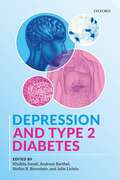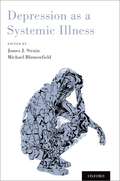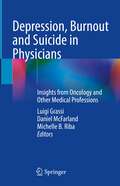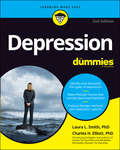- Table View
- List View
Depression and the Erosion of the Self in Late Modernity: The Lesson of Icarus
by Barbara DowdsDepression is not a disease of the brain, a genetic disability or even a mood disorder. Rather, shutdown, numbness or sadness are non-pathological adaptations to adverse childhood and adult environments. This challenging book thus understands depression as a wise response to an unliveable situation. It can teach us what is wrong with our lives and what we must learn in order to go beyond symptom relief and reconnect to our most fundamental needs, relational, existential and spiritual. Because moods shape how we engage with our outer and inner worlds, they underlie all human behaviour. If the sociocultural world is toxic or frustrates our core needs, we will withdraw to protect ourselves. Those who have encountered a non-facilitating environment in childhood will be even more sensitive to adult stresses, since their self-organisation is fragile and non-resilient. As depression is so complex, understanding it demands an integrative approach.
Depression and the Erosion of the Self in Late Modernity: The Lesson of Icarus
by Barbara DowdsDepression is not a disease of the brain, a genetic disability or even a mood disorder. Rather, shutdown, numbness or sadness are non-pathological adaptations to adverse childhood and adult environments. This challenging book thus understands depression as a wise response to an unliveable situation. It can teach us what is wrong with our lives and what we must learn in order to go beyond symptom relief and reconnect to our most fundamental needs, relational, existential and spiritual. Because moods shape how we engage with our outer and inner worlds, they underlie all human behaviour. If the sociocultural world is toxic or frustrates our core needs, we will withdraw to protect ourselves. Those who have encountered a non-facilitating environment in childhood will be even more sensitive to adult stresses, since their self-organisation is fragile and non-resilient. As depression is so complex, understanding it demands an integrative approach.
Depression and the Soul: A Guide to Spiritually Integrated Treatment
by John R. PeteetIn Depression and the Soul, John Peteet proves the old adage that the best physician is also a philosopher. He considers how to approach the problem of depression within a larger context, and reviews current concepts of successful living relative to the heart (emotion and volition), the mind (cognition and coping), and the soul (the self in relation to transcendent reality). Each chapter goes on to further explore the relationship between depression and the context of a patient’s entire life. This is done through consideration of how the existential struggles of depressed individuals engage their spiritual lives, by reviewing current empirical literature on depression and spirituality, comparing the perspectives of various spiritual traditions or world views, and summarizing ways that spirituality and depression interact.
Depression and the Soul: A Guide to Spiritually Integrated Treatment
by John R. PeteetIn Depression and the Soul, John Peteet proves the old adage that the best physician is also a philosopher. He considers how to approach the problem of depression within a larger context, and reviews current concepts of successful living relative to the heart (emotion and volition), the mind (cognition and coping), and the soul (the self in relation to transcendent reality). Each chapter goes on to further explore the relationship between depression and the context of a patient’s entire life. This is done through consideration of how the existential struggles of depressed individuals engage their spiritual lives, by reviewing current empirical literature on depression and spirituality, comparing the perspectives of various spiritual traditions or world views, and summarizing ways that spirituality and depression interact.
Depression and Type 2 Diabetes
by Khalida Ismail Andreas Barthel Stefan R. Bornstein Julio LicinioType 2 diabetes is a major global health concern, and is predicted to affect between 10% to 25% of the world's population in the next 20 years. This epidemic is mostly attributed to ageing populations and unhealthy lifestyles. Thusly, understanding how the mind interacts with the body is essential in unlocking the psychological, biological, and sociocultural processes that increase the risk of type 2 diabetes and make it such a difficult condition to treat. Depression is a common co-morbid condition and when both conditions are present, this poses a significant challenge to patients, clinicians, and health care systems globally. Depression and Type 2 Diabetes is a unique resource offering a fresh scientific approach to this frequent co-morbidity. Using the latest research and guidelines, this resource provides readers with a comprehensive overview of the subject at the different stages of human lifespan, from the uterine environment where the metabolic thermostat is first set, to growing old with diabetes. Written and edited by international experts in diabetes and depression, Depression and Type 2 Diabetes reviews, critiques, and advances the latest research on the prevalent and complex relationship between depression and type 2 diabetes.
Depression and Type 2 Diabetes
Type 2 diabetes is a major global health concern, and is predicted to affect between 10% to 25% of the world's population in the next 20 years. This epidemic is mostly attributed to ageing populations and unhealthy lifestyles. Thusly, understanding how the mind interacts with the body is essential in unlocking the psychological, biological, and sociocultural processes that increase the risk of type 2 diabetes and make it such a difficult condition to treat. Depression is a common co-morbid condition and when both conditions are present, this poses a significant challenge to patients, clinicians, and health care systems globally. Depression and Type 2 Diabetes is a unique resource offering a fresh scientific approach to this frequent co-morbidity. Using the latest research and guidelines, this resource provides readers with a comprehensive overview of the subject at the different stages of human lifespan, from the uterine environment where the metabolic thermostat is first set, to growing old with diabetes. Written and edited by international experts in diabetes and depression, Depression and Type 2 Diabetes reviews, critiques, and advances the latest research on the prevalent and complex relationship between depression and type 2 diabetes.
Depression, Angst, traumatischer Stress und internistische Erkrankungen: Eine psychosomatische und somatopsychische Perspektive
by Hans-Peter KapfhammerKörperliche Erkrankungen gehen in ihrem Verlauf mit einer hohen psychischen Komorbidität einher. Vor allem eine koexistente Depression und Angst, ein chronischer oder traumatischer Stress üben einen relevanten negativen Einfluss auf das dynamische Krankheitsgeschehen aus. Sie sind nicht nur häufig mit einer erhöhten Morbidität, einer ungünstigeren Lebensqualität und belasteten psychosozialen Integration assoziiert. Sie sind oft auch mit einem erhöhten Mortalitätsrisiko und einem bedenkenswerten Suizidrisiko verbunden. Depression, Angst, chronischer und posttraumatischer Stress können auch die Entwicklung von körperlichen Krankheiten beeinflussen, indem sie allgemeine somatische Krankheitsrisiken vermitteln. Sowohl eine psycho-somatische als auch ein somato-psychische Perspektive ist notwendig, um die komplexen Interaktionen zwischen psychologischer, psychosozialer und biologischer Ebene zu erfassen. Ein allgemeiner Teil nimmt das Thema von psychischer und somatischer Komorbidität in einer bidirektionalen Wirkrichtung auf. Er befasst sich mit theoretischen Konzepten und empirischen Befunden zu möglichen Beziehungen zwischen somatischer Krankheit und medizinischer Behandlungsmodalität einerseits und psychischer Vulnerabilität und Störung andererseits, die traditionellerweise einer „psychosomatischen Perspektive“ in der Medizin zugeordnet werden. In einem speziellen Teil werden diese allgemeinen Aspekte einer biopsychosozialen Betrachtung von Depression, Angst und traumatischem Stress in ihrem potentiellen Einfluss auf definierte internistische Krankheitsrisiken bzw. von koexistenter depressiver, Angst- und posttraumatischer Belastungsstörung bei internistischen Erkrankungen in ihren möglichen Auswirkungen auf Krankheitsdynamik und Krankheitsverlauf jeweils nach traditionellen Organsystemen bzw. nach speziellen medizinischen Behandlungskontexten je gesondert dargestellt. Dieses umfangreiche Werk richtet sich gleichermaßen an die Kolleg*innen aus Psychiatrie und Psychotherapie wie aus den medizinischen Fächern, sowie an alle Leser*innen, die an einer psychosomatischen und somatopsychischen Perspektive auf die komplexen wechselseitigen Beziehungen zwischen psychischen Störungen und körperlichen Krankheiten interessiert sind.
Depression, Angst und traumatischer Stress in der Chirurgie: Eine psychosomatische und somatopsychische Perspektive
by Hans-Peter KapfhammerDieses Buch schließt unmittelbar an das „Vorgängerprojekt“ Depression, Angst, traumatischer Stress und internistische Erkrankungen (ISBN 978-3-662-65872-7) an. Ein allgemeiner Einführungsteil stellt das tragende Konzept der somatischen und psychischen Komorbidität dar und unterstreicht einen engen Zusammenhang von körperlichen Krankheiten, medizinischen, hier chirurgischen und anästhesistischen Interventionen und koexistenten depressiven, ängstlichen und (post-)traumatischen Störungen. In einem anschließenden Teil wird dieser biopsychosoziale Fokus dann auf allgemeine Aspekte von Interventionen in Chirurgie und Anästhesie in den prä-, intra- und postoperativen Abschnitten gerichtet. Diese Aspekte werden an den häufigsten Operationen in der Allgemeinchirurgie und Orthopädie veranschaulicht. Das Thema einer affektiven und Stress-bezogenen Komorbidität wird nachfolgend in einzelnen chirurgischen Spezialkontexten erneut aufgenommen, so in der Trauma- und Unfallchirurgie, der Herzchirurgie, der onkologischen Chirurgie, der Adipositaschirurgie sowie der Transplantationschirurgie. Das Buch richtet sich gleichermaßen an Kolleg*innen aus Psychiatrie, Psychosomatik, Psychotherapie und klinischer Psychologie wie auch an Kolleg*innen aus den medizinischen insbesondere den chirurgischen und anästhesistischen Fächern. Es ist auch für alle Personen von Interesse, die sich zu den komplexen psychosomatischen und somatopsychischen Themen in der Chirurgie und Anästhesie orientieren oder mit ihnen näher befassen wollen.
Depression as a Cultural Phenomenon in Postmodern Society: An Analytical-Behavioral Essay of Our Time (SpringerBriefs in Psychology)
by Yara Nico Jan Luiz Leonardi Larissa ZeggioThis book presents an analysis of contemporary society based on the experimental and interpretative models produced by the experimental analysis of behavior, in order to think about the ways in which current social contingencies can affect the life of individuals making them more depressive. It addresses the phenomenon of depression in a broad way. From its conception as a scientific concept to sociological explanations to explain its emergence, the book presents in a very well founded way the necessary knowledge to clarify, understand, and seek treatment and prevention for this major social evil.The authors begin with a description of the current diagnostic parameters of major depressive disorder followed by alarming global epidemiological data showing that depression has affected all races, social classes, genders and creeds. They then address the topic departing from an approach based on the experimental analysis of behavior, but also in dialogue with other philosophical and conceptual traditions, to show how current social relationships contribute to the development of major depressive disorder. Depression as a Cultural Phenomenon in Postmodern Society will be a valuable tool for health professionals looking for a wider approach to depression prevention and treatment. An approach that looks not only to the isolated individual, but takes into account the whole social context that contributes to cause or to prevent major depressive disorder.
Depression as a Systemic Illness
by James J. StrainAlthough depression has been long considered an exclusively mental disorder, this book highlights the importance of recognizing it as a systemic--physical--illness. The chapters herein present key findings from research on animal models before proceding on to examine the "allostatic" load that depression bears on the body, commonly observed patterns of depression, and illnesses that it is likely to adversely effect--through mechanisms other than that of non-compliance with treatment. The authors also explore various diagnostic dilemmas including symptom-driven, phenomenologic approaches, and discuss drug-drug interactions and the use of unique electronic health records as collaborating agents to the physician. Depression as a Systemic Illness emphasizes the need for the primary care physician to be the first agent to care for "garden variety" depressive disorders and the need to alter medical school and residency training to accommodate the development of the necessary skills, knowledge and attitudes to fulfill this goal. Its unique approach and presentation of depression makes it a key resource for clinicians within the fields of both psychiatry and primary care medicine.
Depression as a Systemic Illness
Although depression has been long considered an exclusively mental disorder, this book highlights the importance of recognizing it as a systemic--physical--illness. The chapters herein present key findings from research on animal models before proceding on to examine the "allostatic" load that depression bears on the body, commonly observed patterns of depression, and illnesses that it is likely to adversely effect--through mechanisms other than that of non-compliance with treatment. The authors also explore various diagnostic dilemmas including symptom-driven, phenomenologic approaches, and discuss drug-drug interactions and the use of unique electronic health records as collaborating agents to the physician. Depression as a Systemic Illness emphasizes the need for the primary care physician to be the first agent to care for "garden variety" depressive disorders and the need to alter medical school and residency training to accommodate the development of the necessary skills, knowledge and attitudes to fulfill this goal. Its unique approach and presentation of depression makes it a key resource for clinicians within the fields of both psychiatry and primary care medicine.
Depression, Burnout and Suicide in Physicians: Insights from Oncology and Other Medical Professions
by Luigi Grassi Daniel McFarland Michelle B. RibaThis book provides a reference and contextual basis for depression, burnout and suicide among oncology and other medical professionals. Oncology as a medical subspecialty is at a unique apex of this crisis. While the same pressures in medicine certainly apply to oncologists, oncology is particularly stressful as a changing field with diverse patient and societal expectations for outcomes. In addition to experiencing the stress of caring for patients that could succumb to their cancer diagnoses, these professionals are regularly confronted with an onslaught of new medical information and a landscape that is changing at a breakneck pace. These are just a few factors involved in the increasing rates of burnout among oncologists as well as other medcial professionals. By addressing a gap in identifying mental health problems among health care professionals, this book sheds light on mental health problems and suicide among physicians. Importantly, this book is a call to action of the professional and administrative organizations to work on improving mental health of physicians. Anxiety and depression affect not only the individual doctor but also patient care. Given the increasing attention to these issues along with limited yet applicable data regarding how to address these issues, the text aims to bring the latest data face to face with consensus opinion and can be used to ultimately enhance oncologic and psychiatric practices. Written by experts in the field, Depression, Burnout and Suicide in Physicians: Insights from Oncology and Other Medical Professions aims to significantly increase awareness and contribute to understanding the necessity of preventive measures on individual, family, and care givers levels.
Depression Care Across the Lifespan
by Lynne WalshDepression Care across the Lifespan is a comprehensive, practical text that aims to increase knowledge and understanding of depression enabling professionals to enhance the care delivered to patients with depression. This text explores depression across all ages, starting with children and teenagers, through adulthood and finally old age. Depression Care across the Lifespan explores depression amongst different groups including children and teenagers, depression throughout the adult female lifecycle and depression in later life. It also discusses the impact of depression in people with learning disabilities and those from ethnic minority and immigrant populations. It also looks at topics including the causes and treatment of depression, the impact of stress and depression upon work and wellbeing, depression in chronic illness, suicide and self harm, and managing depression in primary and secondary care are included. Key features: • Essential reading for practitioners involved in the care of depressed people • Useful for students undertaking nursing, health and social care courses • Evidence-based, and supported by relevant literature • Links policy with current practice across the whole lifespan
Depression Conceptualization and Treatment: Dialogues from Psychodynamic and Cognitive Behavioral Perspectives
by Christos Charis Georgia PanayiotouDepression, a highly common clinical disorder, is an important and clinically relevant topic for both clinical researchers and practitioners to address, because of its prevalence, impact on the individual and society, association with other mental and physical health problems and the social contexts in which it develops. Depression ranks in Germany and central Europe as the third among the leading mental disorders and world-wide is a leading cause of disability. It is estimated that 8.3 % of the German population is depressed within a year (11.2 % women, 5.5 % men). These statistics mean that 4 million people per year are depressed in Germany alone (one year prevalence). According to the WHO, over 300 million people world-wide experience depression and in the USA the financial burden of this disorder, due to disability and work absenteeism, reaches Depression is also becoming more frequent over time and has a high risk of recidivism –particularly since its most common form, Major Depressive Disorder (DSM-5; ICD10) tends to occur in episodes. For example, 20% to 40% of people become depressed again within two years after their first depressive episode, meaning that a major aim of any therapeutic intervention should be to prevent future relapses. Depression also shows very high comorbidities with other mental and physical health conditions. Its overlap with anxiety pathology is so high that clinicians are concerned with whether the two disorder categories are indeed distinct or if they show substantial etiological overlap. Depression is also associated with heart disease and even cancer, making it a risk factor for mortality and morbidity that needs to be identified early and addressed effectively. In addition to Major Depressive Disorder, the often severe Bipolar Disorder, and the chronic form of Depression referred to as dysthymia are additional mood disorders that among them require careful differential diagnosis. They also lead to questions regarding their common or distinct etiological mechanisms. In order to gain a better understanding of Depression as a clinical disorder, one needs to look at it as a multifaceted phenomenon. Depression is a neurobehavioral condition, and one has to be up to date and have solid understanding of its biological substrate, at a genetic, neuronal, hormonal and pharmacological level. Depression is also a socio-demographic phenomenon, and one needs to examine its epidemiology, that might contain significant cues towards its clearer understanding. It is more prevalent, for example, in certain regions, climates, age groups and genders (much more prevalent in women, with age of appearance in young adulthood but also presents as a significant problem for youth and the elderly), is associated with stereotypes and stigma and can be the aftermath of crises, trauma and loss. The etiology of Depression remains under scrutiny, though recently much more knowledge is emerging from contemporary neuroimaging, genotyping and data science methods. Different neural and behavioral systems may be involved contributing to the significant heterogeneity within the disorder. Social roles, stressors, attachment patterns, family support and social networks, and individual (e.g. gender linked) vulnerabilities may contribute significantly towards increasing risk for developing depression. Different therapeutic approaches, like those stemming from the psychoanalytic/psychodynamic perspectives and those stemming from the cognitive/behavioral (2nd and 3rd wave) tradition focus on the components of etiology considered most dominant. As science progresses with clearer evidence regarding the important etiological factors and their interactions, these different perspectives, each with its own contribution, may need to take new developments into consideration, adapt and even begin to converge. These different aspects of the topic of Depression, which are central to the scientific aims of clinical scientists, but also permeate the way cl
Depression For Dummies
by Laura L. Smith Charles H. ElliottThe good news on beating the blues Do you want the good, the bad, or the best news first? OK, the bad news is that an estimated 264+ million people worldwide suffer from a depressive illness. The good news is that we know how to defeat these illnesses better than ever before using a growing range of highly effective psychotherapies, medications, and other therapeutic methods that are improving all the time. And the best news: because of these advances, the majority of people no longer need to suffer the debilitating—and sometimes dangerous—effects of long-term depressive illness. The new edition of Depression For Dummies shows how you can make this happen for you by providing the latest and best information on how to banish the noonday demon and bring the sunshine back into your world. In this friendly, cheerful, no-nonsense guide, leading clinical psychologists Laura L. Smith and Charles H. Elliot give you the straight talk on what you face and proven, practical advice on how to punch back and win. Showing you how to know your enemy, they demystify common types of depression, explain its physical effects, and help identify the kind you have. Armed in this way, you can take firmer steps toward the lifestyle changes—as well as therapy or medication—that will put you back in control. Learn about different forms of depression Build simple, daily habits into your life that help banish the blues Understand conventional, alternative, and experimental therapies Move on: avoid relapses and stay happy! Whatever your level of depression—occasional bouts or long-term—this book gives you the insight, the tools, and the inner strength and persistence to put enjoyment back in your life.
Depression For Dummies (For Dummies Ser.)
by Laura L. Smith Charles H. ElliottThe good news on beating the blues Do you want the good, the bad, or the best news first? OK, the bad news is that an estimated 264+ million people worldwide suffer from a depressive illness. The good news is that we know how to defeat these illnesses better than ever before using a growing range of highly effective psychotherapies, medications, and other therapeutic methods that are improving all the time. And the best news: because of these advances, the majority of people no longer need to suffer the debilitating—and sometimes dangerous—effects of long-term depressive illness. The new edition of Depression For Dummies shows how you can make this happen for you by providing the latest and best information on how to banish the noonday demon and bring the sunshine back into your world. In this friendly, cheerful, no-nonsense guide, leading clinical psychologists Laura L. Smith and Charles H. Elliot give you the straight talk on what you face and proven, practical advice on how to punch back and win. Showing you how to know your enemy, they demystify common types of depression, explain its physical effects, and help identify the kind you have. Armed in this way, you can take firmer steps toward the lifestyle changes—as well as therapy or medication—that will put you back in control. Learn about different forms of depression Build simple, daily habits into your life that help banish the blues Understand conventional, alternative, and experimental therapies Move on: avoid relapses and stay happy! Whatever your level of depression—occasional bouts or long-term—this book gives you the insight, the tools, and the inner strength and persistence to put enjoyment back in your life.
Depression im Alter – Eine Frage der Emotionsregulation: Längsschnitt zum Zusammenhang von Emotionsregulationskompetenz und Depression
by Nadine Becker-HingstIn diesem Open-Access-Buch geht es um die Frage, ob Emotionsregulationsprobleme eine Bedeutung für die Depression im höheren Erwachsenenalter haben. Depressionen sind in dieser Altersgruppe weit verbreitet, werden aber häufig nicht adäquat behandelt oder sogar als Teil des natürlichen Alterungsprozesses hingenommen. Ein Grund liegt in dem geringen Wissen um diese Erkrankung. Aus anderen Altersgruppen wissen wir, dass Regulationsprobleme mit Depressivität assoziiert sind. Im höheren Erwachsenenalter ist dieser Zusammenhang nahezu unerforscht. Um diese Lücke zu schließen, wurden Menschen im höheren Alter mit und ohne Depression untersucht. Das Ergebnis: Bei gesunden älteren Menschen hatte Regulationskompetenz einen positiven Einfluss auf das Wohlbefinden und war sogar Schutzfaktor gegen Depressionen. Patient:innen in klinischer Depressionsbehandlung profitierten im Hinblick auf den Outcome ihrer Behandlung ebenfalls von höherer Regulationskompetenz. Allerdings spielte Akzeptanz hier eine überraschende Rolle. Die Untersuchung liefert Hinweise, dass die Förderung emotionaler Kompetenz auch im Alter ein wirksamer Baustein psychotherapeutischer Behandlung sein kann.
Depression in African American Clergy (Black Religion/Womanist Thought/Social Justice)
by Wynnetta WimberleyIn this book Wynnetta Wimberley addresses the often overlooked crisis of depression in African American clergy, investigating the causes underlying this phenomenon while discussing possible productive paths forward. Historically, many African American pastors have had to assume multiple roles in order to meet the needs of congregants impacted by societal oppression. Due to the monumental significance of the preacher in the African American religious tradition, there exists a type of ‘cultural sacramentalization’ of the Black preacher, which sets clergy up for failure by fostering isolation, highly internalized and external expectations, and a loss of self-awareness. Utilizing Donald Winnicott’s theory of the ‘true’ and ‘false’ self, Wimberley examines how depression can emerge from this psycho-socio-theological conflict. When pastors are depressed, they are more prone to encounter difficulties in their personal and professional relationships. Drawing from a communal-contextual model of pastoral theology, this text offers a therapeutically sensitive response to African American clergy suffering with depression.
Depression in African American Clergy (Black Religion/Womanist Thought/Social Justice)
by Wynnetta WimberleyIn this book Wynnetta Wimberley addresses the often overlooked crisis of depression in African American clergy, investigating the causes underlying this phenomenon while discussing possible productive paths forward. Historically, many African American pastors have had to assume multiple roles in order to meet the needs of congregants impacted by societal oppression. Due to the monumental significance of the preacher in the African American religious tradition, there exists a type of ‘cultural sacramentalization’ of the Black preacher, which sets clergy up for failure by fostering isolation, highly internalized and external expectations, and a loss of self-awareness. Utilizing Donald Winnicott’s theory of the ‘true’ and ‘false’ self, Wimberley examines how depression can emerge from this psycho-socio-theological conflict. When pastors are depressed, they are more prone to encounter difficulties in their personal and professional relationships. Drawing from a communal-contextual model of pastoral theology, this text offers a therapeutically sensitive response to African American clergy suffering with depression.
Depression in Children and Adolescents
by Kedar Nath Dwivedi Ved Prakash VarmaThis book, which draws together contributions from specialists in child, adolescent and family psychiatry, child psychotherapy, social work, community psychiatric nursing, educational therapy, special needs coordination in teaching, and general practice, provides a valuable resource for those professionals in contact with young people suffering from depression.
Depression in Children and Adolescents (Routledge Library Editions: Adolescence)
by Harold S. Koplewicz Emily KlassOriginally published in 1993, this title has contributions from many internationally respected experts from this field. The book covers the following areas: theories of development and etiology of depression; medical illness and depression; depression and other psychiatric conditions; treatment approaches to depression. The book has been written in such a way that research, clinical and psychiatric issues are easily understood. It will still be of interest and value to paediatricians, mental health practitioners and researchers in the field.
Depression in Children and Adolescents (Routledge Library Editions: Adolescence #Vol. 6)
by Harold S. Koplewicz Emily KlassOriginally published in 1993, this title has contributions from many internationally respected experts from this field. The book covers the following areas: theories of development and etiology of depression; medical illness and depression; depression and other psychiatric conditions; treatment approaches to depression. The book has been written in such a way that research, clinical and psychiatric issues are easily understood. It will still be of interest and value to paediatricians, mental health practitioners and researchers in the field.
Depression in Girls and Women Across the Lifespan: Treatment Essentials for Mental Health Professionals
by Laura H. ChoateDepression in Girls and Women Across the Lifespan takes a broad biopsychosocial approach to understanding the onset and experience of depression in women. The book is structured around four major life transitions: depression during puberty and the transition to adolescence; Premenstrual Dysphoric Disorder and a woman’s transition through monthly cycles of depression; depression during pregnancy, postpartum, and the transition to motherhood; and depression during perimenopause and the transition to menopause. Integrating cutting-edge research with a wealth of case examples and specific evidence-based interventions, the book expands our understanding of depression by taking into account the biological realities, psychological vulnerabilities, life stressors, and gendered cultural messages and expectations that intersect to shape the onset of depression in women’s lives. Written in a clear, applicable style, Depression in Girls and Women Across the Lifespan enables mental health professionals to provide effective, gender-informed, depression-focused treatments that are tailored to girls’ and women’s unique needs.
Depression in Girls and Women Across the Lifespan: Treatment Essentials for Mental Health Professionals
by Laura H. ChoateDepression in Girls and Women Across the Lifespan takes a broad biopsychosocial approach to understanding the onset and experience of depression in women. The book is structured around four major life transitions: depression during puberty and the transition to adolescence; Premenstrual Dysphoric Disorder and a woman’s transition through monthly cycles of depression; depression during pregnancy, postpartum, and the transition to motherhood; and depression during perimenopause and the transition to menopause. Integrating cutting-edge research with a wealth of case examples and specific evidence-based interventions, the book expands our understanding of depression by taking into account the biological realities, psychological vulnerabilities, life stressors, and gendered cultural messages and expectations that intersect to shape the onset of depression in women’s lives. Written in a clear, applicable style, Depression in Girls and Women Across the Lifespan enables mental health professionals to provide effective, gender-informed, depression-focused treatments that are tailored to girls’ and women’s unique needs.
Depression in Japan: Psychiatric Cures for a Society in Distress
by Junko KitanakaSince the 1990s, suicide in recession-plagued Japan has soared, and rates of depression have both increased and received greater public attention. In a nation that has traditionally been uncomfortable addressing mental illness, what factors have allowed for the rising medicalization of depression and suicide? Investigating these profound changes from historical, clinical, and sociolegal perspectives, Depression in Japan explores how depression has become a national disease and entered the Japanese lexicon, how psychiatry has responded to the nation's ailing social order, and how, in a remarkable transformation, psychiatry has overcome the longstanding resistance to its intrusion in Japanese life. Questioning claims made by Japanese psychiatrists that depression hardly existed in premodern Japan, Junko Kitanaka shows that Japanese medicine did indeed have a language for talking about depression which was conceived of as an illness where psychological suffering was intimately connected to physiological and social distress. The author looks at how Japanese psychiatrists now use the discourse of depression to persuade patients that they are victims of biological and social forces beyond their control; analyzes how this language has been adopted in legal discourse surrounding "overwork suicide"; and considers how, in contrast to the West, this language curiously emphasizes the suffering of men rather than women. Examining patients' narratives, Kitanaka demonstrates how psychiatry constructs a gendering of depression, one that is closely tied to local politics and questions of legitimate social suffering. Drawing upon extensive research in psychiatric institutions in Tokyo and the surrounding region, Depression in Japan uncovers the emergence of psychiatry as a force for social transformation in Japan.
















